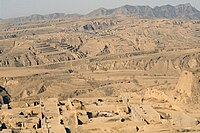
Photo from wikipedia
Abstract Rare earth elements (REEs) have been widely used to infer the provenance of sediments. However, sedimentary sorting and chemical weathering may produce REE compositions within sediments that vary with… Click to show full abstract
Abstract Rare earth elements (REEs) have been widely used to infer the provenance of sediments. However, sedimentary sorting and chemical weathering may produce REE compositions within sediments that vary with grain size, leading to complications and uncertainty when tracing possible source areas. In desert areas, the extent to which REE compositions within eolian sands are affected by sedimentary sorting along with which REE proxies can be used to indicate provenance requires further study. During our work, 73 samples were collected from the Badain Jaran Desert (BJD) and some nearby regions. These were analyzed for trace elements and REEs. Our results showed that the REE composition of these eolian sands varied considerably among the various grain-size fractions. We conclude that the REE composition of these eolian sands in the BJD is a function of sedimentary sorting and provenance rather than of chemical weathering. Among the REE proxies considered, variations in (La/Yb)N and Y/REE values seem mainly to have been affected by sedimentary sorting, whilst δCe, (La/Sm)N, (La/Gd)N, Y/Tb, Y/Er, and Ce/Nd ratios appeared primarily to have been governed by provenance. Therefore, we can infer that care is needed when using (La/Yb)N and Y/REE as proxies for determining eolian sand provenance; however, δCe, (La/Sm)N, (La/Gd)N, Y/Tb, Y/Er, and Ce/Nd ratios offer a more reliable perspective. Moreover, by using (La/Sm)N and (La/Gd)N as provenance proxies, we determined that hinterland lacustrine sediments are an important source of
Journal Title: Catena
Year Published: 2021
Link to full text (if available)
Share on Social Media: Sign Up to like & get
recommendations!